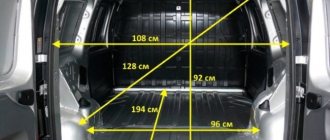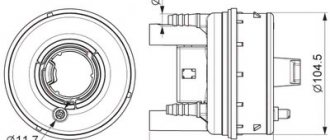Lada Largus cars are a new line of commercial vehicles produced by AvtoVAZ. They first rolled off the assembly line in 2011, and full-scale production began in 2012. The design was developed jointly with the foreign machine manufacturer Renault. The car turned out to be roomy, powerful and inexpensive, which very quickly made it popular among its compatriots.
Gasoline consumption of Lada Largus according to the passport
The passport values for gasoline consumption of the Lada Largus are determined after assembly, in factory testing laboratories. At the same time, such measurements are for informational purposes only, since the laboratory does not take into account additional influencing factors.
The table shows the fuel consumption figures for the Lada Largus, which are indicated by AvtoVAZ according to the passport. Basically, the difference in numbers is due to different engine sizes and horsepower. Fuel consumption for Lada Largus:
| Engine volume, l | Power, hp | Transmission type | Average consumption per 100 km, l | Fuel consumed |
| LADA Largus 1st generation (2012) |
| 1,6 | 84 | Manual transmission | 8,1-8,6 | Unleaded gasoline AI-92 |
| 87 | Manual transmission | 8,2-8,7 |
| 102 | Manual transmission | 7,8-8,3 |
| 105 | Manual transmission | 7,8-8,4 |
| 106 | Manual transmission | 7,9-8,5 |
| LADA Largus (modification R90) |
| 1.6 | 84 | Mechanical transmission | 8,1-8,8 | Unleaded fuel AI-92 |
| 87 | 8,2-8,9 |
| 102 | 7,8-8,6 |
| 105 | 7,7-8,8 |
| 106 | 7,9-8,9 | Gas fuel |
| LADA Lardus (2020 modification) |
| 1,6 | 87 | Manual transmission | 8,1-8,9 | Gasoline AI-92 |
Please note that the 82 hp versions and 85 hp can not be. In fact, the passport values of gasoline consumption for the Lada Largus are provided for informational purposes only. If we compare them with real indicators, we will see that the numbers are different.
This happens because real factors such as driving style, type of road surface and fuel quality. This leads to the fact that the amount of fuel per 100 kilometers increases significantly compared to the technical passport.
Lada Largus 1.6 (105 hp) 16 cl.
The last in the line of power plants of the Lada Largus is a 1.6-liter engine with a power of 105 hp, which also runs on gasoline. Torque of 148 Nm makes it possible to accelerate to 183 km/h. The engine is equipped with a five-speed manual transmission.
Reviews about the consumption of Lada Largus 1.6 (105 hp)
- Maxim, Kyiv. I am the owner of a Lada Largus built in 2014, 1.6, manual transmission. I have a large family, according to the budget it was quite possible to buy a new car, we settled on this cruiser from our native AvtoVAZ, and did not regret it. There has never been a time when we didn’t take something due to lack of space. His appetite is not very large, 9.5 liters on average.
- Yakov, Moscow. I have a Lada Largus 2013, 1.6, 105 hp, manual transmission. For me, the downside is the soft suspension, I like it harder, but this is a personal opinion. But the car is quite good, with a reasonable appetite. In the city it takes 11-12 liters, on the highway 8-9 liters.
- Stanislav, Alushta. In terms of price/quality ratio, the Lada Largus is completely worth the investment. After a year of ownership, I can say that I am not satisfied with the sound insulation and the large amount of dust in the cabin. But these problems are easily solved. It consumes fuel in normal sizes - from 9 to 12.5 liters.
- Roman, St. Petersburg. Lada Largus 2013, bought new, has already driven more than 55 thousand km. I use it as a work vehicle and transport various loads. Everything is fine, so far there have been no breakdowns, we can thank the designers. Gasoline consumption is 7-10 liters.
- Andrey, Ufa. With the birth of my third child, the question arose about buying a fairly spacious car, the Lada Largus caught my eye, we tried it and liked it. We took the 2020 model with maximum engine power. In the city you can feel the size, but on the highway it’s simply beautiful! Consumes an average of 9 liters of gasoline.
- Igor, Yekaterinburg. I’ve had the Lada Largus for two years now, so far I can’t say anything bad, it’s even somehow strange, it seems to be a domestic car, but I’m happy with everything. After the first maintenance I can say that maintenance is a bit expensive. It seems to me that consumption of 12.5 liters in the city is a lot.
- Denis, Omsk. I have a Lada Largus 2014, 1.6, 105 horsepower, manual. Excellent spaciousness, obedient steering, good cross-country ability. Thanks to its high ground clearance, it behaves like an SUV. Fuel consumption is on average 9 liters.
- Alexander, Moscow. I got Lada Largus as soon as there was a new addition to the family. A good investment considering the package included. I have enough of everything, both power and dynamics. But there are problems with the foglights; they don’t light up at all. On average it consumes 9 liters of fuel.
Real fuel consumption figures
Some cars are produced with 8 valves in engines. There are versions with 84 hp. and 87 hp The manufacturer promises that these cars will “eat” 10.5-10.6 liters on city streets and 6.5-6.9 liters on the highway. In reality, the values differ greatly.
For 84 hp engines. and 87 hp have approximately the same consumption in real conditions. The values are as follows:
- When driving in the city, in traffic jams and difficult traffic conditions - 12.4-13.8 l;
- If you often have to drive on the highway, between cities – 8.2-8.9 liters;
- When driving in the combined cycle - 10.1-10.9 liters.
Power plants 102 hp, 105 hp and 106 hp consume more gasoline than less powerful versions. However, the numbers are quite adequate, which contribute to fuel savings. In real conditions, the indicators are:
- Driving on city roads – 12.6-13.9 l;
- Driving on highways – 8.6-9.4 l;
- Driving both on the road and on the highway – 10.5-11.6 liters.
It must be borne in mind that consumption figures fluctuate greatly, depending on environmental conditions. In winter and at low temperatures, the specified gasoline consumption standards increase.
Those cars that are equipped with engines of 102 hp, 105 hp. and 106 hp have a basic design with 16 valves. This had a good effect on the power and dynamics of the car. Unfortunately, a negative trend towards increased gasoline consumption has emerged. For all these three engine variations, the numbers are approximately the same - we list them:
- Operating the car in the city, on a busy road – 12.5-13.6 l;
- Driving between populated areas on the highway – 8.9-9.7 l;
- Mixed operating cycle – 10.3-10.9 l.
Lada Largus fuel consumption with different Lada Largus engines
The fuel consumption of the Lada Largus worries buyers quite seriously. After all, gasoline prices are constantly rising, and you want to know the real fuel consumption of the Lada Largus in advance. So that 13 liters in the city would not come as a big surprise.
But it is worth noting that the domestic station wagon initially had 8 and 16 valve engines running on AI-92 gasoline. Today, the engines are different and the fuel requirement has increased to AI-95, due to the new Euro-5 environmental standards.
At the start of sales, the Largus was equipped with an 8-valve Renault K7M with a volume of 1.6 liters (84 hp), which until recently was imported from Romania.
Now this engine has been replaced with a domestic 8-valve VAZ-11189 of the same volume with a power of 87 hp, the engine turned out to be slightly more economical.
The second engine of the same volume with 16 valves and 105 hp. also a development of Renault K4M . It was also originally imported from the European Renault plant. But today this engine is assembled in Tolyatti and after manipulating the settings it produces only 102 hp.
The rather old design of gasoline atmospheric power units does not have complex supercharging systems, variable valve timing on camshafts or direct fuel injection.
On the one hand, a fairly simple device allows us to talk about good maintainability of 1.6 liter engines.
But on the other hand, the engines are very voracious and do not allow us to talk about some kind of modern dynamics.
Below are the official fuel consumption characteristics of the Lada Largus .
Fuel consumption Lada Largus 8-valve 87 hp
- Engine type – VAZ-11189
- Consumption in the city – 10.6 liters
- Highway consumption – 6.7 liters
- Average consumption – 8.2 liters
- Acceleration to hundreds – 14.5 seconds
- Maximum speed – 156 km/h
- Fuel type – gasoline AI-95
Highway consumption
In order to find out exactly how much fuel Largus consumes, it is necessary to separately evaluate consumption in urban conditions and on the highway. The second option will always have lower numbers, since driving outside the city does not require sudden acceleration and braking. Promotes reduction and movement at one, stable speed.
If we look at the reviews of car owners, the real consumption figures outside the city limits are 6.8-7.3 liters of AI-92 per 100 kilometers. If you remember the values indicated in the passport, then this parameter is indicated there as 6.3-6.7 liters. In principle, this is an insignificant difference.
Fuel consumption in urban conditions
If you mainly plan to drive along the streets of a large city, then you need to prepare for the fact that the “appetite” for gasoline will increase significantly. This will be affected by several factors:
- A driving style in which it is necessary to constantly brake sharply and pick up speed just as sharply;
- The need to stand in traffic jams;
- Parking with the engine running;
- Lower fuel quality.
If you look at the reviews of Largus owners on the Internet, they write that gasoline consumption values are 11.9-12.5 liters per 100 kilometers. Please note that if you measure this value in another vehicle, the values may differ. The reason for this is individual factors that make adjustments to the number of liters of gasoline spent per hundred. Experienced auto mechanics recommend measuring fuel readings only on an individual basis.
How to reduce fuel consumption
There are several ways to reduce Largus' appetite for gasoline. Before troubleshooting, try all of the following measures. All of them allow you to achieve a significant effect:
- Largus does not have very good aerodynamic characteristics, due to which the air flow resistance increases greatly. You can install special aerodynamic kits that will neutralize the impact of air masses. You should make accurate calculations and not buy makeshift kits;
- Fine settings thanks to chip tuning. Reflashing the electronic control unit will allow you to set precise fuel dosage settings, as well as increase the completeness of combustion of the mixture. All this will allow you to save up to 15% on gasoline;
- Refuel only at proven gas stations and do not use cheap gasoline. Savings of several hundred rubles will not cover the costs of subsequent repairs;
- Optimizing driving style and style. Avoid sudden acceleration and braking. On the highway, drive only at a stable speed of 100-110 km/h;
- Gas equipment can be installed. This will allow you to use liquefied gas for refueling, which is much cheaper than gasoline.
Owner reviews
Maxim from Lipetsk. I use Largus mainly for work - transporting small loads around the city. I like that in 3 years of operation nothing serious has broken down, the car is reliable and comfortable. My fuel consumption in the city is 12.4-12.9 liters, if I need to go to a neighboring region, then it’s less - about 9.5-9.8 liters.
Pavel from Rostov-on-Don. I bought Largus as a second car for the family. A spacious station wagon was needed to transport things to the country and home. I like the powerful engine - I have the 102 hp version. Consumption is normal - 11.8-11.9 liters in the city and 9.6-9.9 on the highway.
Timofey from Barnaul. I got a Largus 87 hp. with a mileage of 85,000 kilometers. I rebuilt the front suspension, otherwise there were practically no problems. The engine is powerful and reliable – it can even pull a loaded car. Consumption is not high, on average 10-12 liters.
Fuel level indicator scale
| Author: G.V.G. Published: 1641 days ago (May 4, 2016) Logbook: Lada Largus 7 seats equipment 02D Category: Uncategorized | +23↑ Votes: 23 |
I have always wondered how many liters of gasoline in the tank correspond to each “stick” on the fuel gauge. Through the test mode of the instrument panel, I “caught” all the transient modes of ignition and attenuation of the “sticks”. Of course, more than 50 liters is not taken into account. The light comes on when there is 7 liters left. Well, in general, what I got on my deluxe, by the way, on the Internet I saw the same detail for Logan, and so, they do not match with Largus. The number on the left shows with what amount of gasoline the stick is lit, on the right until the amount of gasoline the next “stick” is not yet ignited.
← Silicone case for signaling | Boxes for luxury seats, or… →
Create your own logbook, and you will be able to share with forum members your opinion about Largus, useful developments, installed additional information. equipment and tuning, trips and travel! To create a logbook, you must register on the site.
Popular in in-flight magazines
DRL Traveling on Largus Fuel consumption Armrest Mileage Discs Radio To1 First impressions Buying Largus Electrics Covers for Largus Bumper net Modifications HBO Speakers Rear view camera Wipers Interior lighting Brake light Tuning Tires and wheels Check valve Tuning lights Noise insulation Winter tires Rugs Largus DVR Rki-19 Winter operation Roof box PTF Tail lights Izhevsk Car audio Injectors Mudguards Washer reservoir Hood stops Low beam lamp Installing a cabin filter Parking sensors Thresholds Lada Largus LED Carpet covers Floating idle speed Trunk lighting Tinting Trunk shelf Trip to the sea Hood seal Accident Owner's review Fender liners Walkie Talkie Additional Socket Eyeglass case Replacement 5th gear
Comments (26)
| Triathlon May 4, 2020 at 08:05 pm +4 |
| The numbers in the table confirm my subjective observations that as the fuel level in the tank decreases, the “sticks” of the UUT begin to go out faster. |
|
| Alexey May 4, 2020 at 10:17 pm 0 |
| Plus, I was always tormented by the question of how much fuel was left on the sticks |
|
| Evgeniy Minsk May 4, 2020 at 10:44 pm 0 |
| So what is the volume of the tank? 57 l? |
|
| GVG May 4, 2020 at 10:53 pm +2 |
| 60-65 liters, depending on patience, pour slowly |
|
| LarqusMen585 May 4, 2020 at 11:16 pm +1 |
| not 60, but 65 and above…. I’ll tell you about the reserve light - it came on, I stopped, checked in the test = showed 8 lit (although I believe there are errors) |
|
| GVG May 5, 2020 at 00:51 0 |
| it lights up at 7 liters, and does not go out; if the level rises until you turn the ignition off/on, it does not light up immediately; there is some delay. I can’t say about 65 and above, I didn’t pour it with a measuring cup, but it’s realistic to pour 60-65. |
|
| LarqusMen585 May 5, 2020 at 07:12 +1 |
| You don’t need any measuring cups/beakers - you drive up, look at the remainder in the tank, calculate (assuming that the tank is 65 liters), order until it’s full, pour (push)….Usually I pressed in 65 liters, sometimes more got in (about less, no idea. . and talk)…….- My next trip (March 2016) The rest -
The image has been reduced. Click to see original. I pressed so much-
The image has been reduced. Click to see original. …… Previous trip-
The image has been reduced. Click to see original.
The image has been reduced. Click to see original. everything fits without beakers..... in March I really doused the car with a little bit. |
|
| GVG May 5, 2020 at 08:57 0 |
you yourself say “65 and you can wet yourself” so it turns out 60-65 is guaranteed  |
|
| LarqusMen585 May 5, 2020 at 8:30 pm +1 |
| Well, if so, then definitely! |
|
| 2 brother May 7, 2020 at 06:37 +1 |
| It’s amazing where your technology has come, but ours is more vintage
|
|
| Andrew46 May 5, 2020 at 06:03 +1 |
| In Belarus you have a different liter. I already wrote about this. With a remainder of 6 liters, you barely filled 45 with 3 cut-offs, we have the same flow and without cut-offs. You need to check it with a beaker. |
|
| Dima May 5, 2020 at 1:25 pm 0 |
| Unfortunately, my 11 liter fuel remaining light comes on...why is that interesting? |
|
| GVG May 5, 2020 at 2:41 pm 0 |
| why did they decide this? |
|
| Dima May 6, 2020 at 03:54 pm 0 |
| Why? yes, as if the lamp had come on, I stopped on the horizontal surface, waited 5-7 minutes (on purpose) to eliminate bumpiness, etc. I switched the tidy into test mode. The tidy showed 11 liters of residue. Then it gets more interesting - I remove the terminal with the battery, I put it back on the dashboard, one bar is on again. I drive a short distance (maximum 500 meters) and the fuel remaining lamp comes on again. I stop, there are still 11 liters in the tank, in test mode |
|
| GVG May 6, 2020 at 6:43 pm 0 |
| The lamp comes on when the FLS shows 7 liters, and does not go out again, i.e. if you were driving slightly downhill and for some time (I don’t know how long either, but maybe a few seconds are needed for the FLS to constantly show 7 or less liters) the tidy saw 7 liters, it will light up the light, when the level levels out the light will continue to burn, at how many liters it goes out, I don’t know. |
|
| LarqusMen585 May 6, 2020 at 08:33 pm +1 |
| I haven’t looked into it much, but I think 11L is a lot for a reserve. |
|
| GVG May 13, 2020 at 7:02 pm 0 |
| Today the light came on again, in general its operating algorithm is quite simple, as I said, the light comes on when the last division goes out, the last division goes out when there are less than 7 liters in the tank according to the FLS. In general, the lamp lights up, in test mode it shows on a slope of 10 l and both the last division and the lamp are on, in normal mode the last division does not light up, but the lamp is on, it seems that in test mode the lamp works according to the general algorithm, i.e. In order not to take into account fluctuations in gasoline in the tank, the indicator in normal mode has greater inertia, i.e. In order to turn off the lamp, I would have to stand for a while so that the last indicator would light up. In general, the lamp lights up at 7 liters or less according to the FLS |
|
| 2 brother May 7, 2020 at 06:38 0 |
| Plus for the research done |
|
| alexei May 7, 2020 at 06:51 0 |
| By the way, if you conduct the same research on the second scale (OZ), the result will be much more interesting and very diverse. |
|
| GVG May 7, 2020 at 08:16 +1 |
| It’s easier here, most likely it coincides with Logan, at least 50 and 80 degrees, I looked at the ELM327, I can’t check the rest of the temperature values, sorry
|
|
| alexei May 7, 2020 at 08:39 0 |
| Only at first glance, I have 2 sticks - 51* and 4re - 66* (I checked both MK and OD)! If you collect all the statistics, then But here one specific Largus will not do. |
|
| GVG May 7, 2020 at 08:43 0 |
The image has been reduced. Click to see original. but it all depends on the version of the tidy software. I think
OPAV can easily dot the T’s by just looking at the tidy software that is installed on Largus |
|
| Dima May 7, 2020 at 1:34 pm 0 |
| Four “sticks” for me (personally) light up at 70 degrees. Elm + multitronics. The rest of the data is the same |
|
| GVG May 7, 2020 at 6:38 pm 0 |
| Anything is possible, it was a long time ago, I don’t remember, I need to check again |
|
| Ваdemus May 9, 2020 at 05:39 pm 0 |
| If you look at the ELM, then I have 2 sticks at 53°, and four at 82°. |
|
| Dima May 13, 2020 at 09:45 pm 0 |
| circled, how is it calibrated? |
|
| Add a comment | RSS comments feed |
Additional comments:












